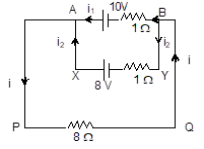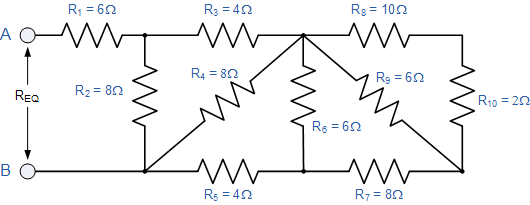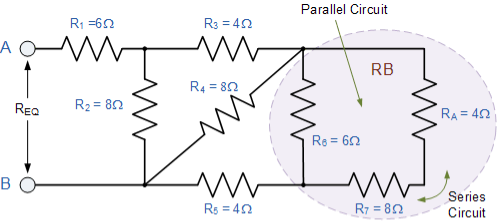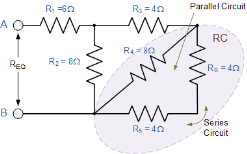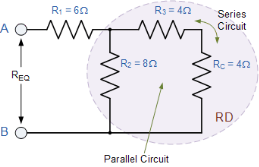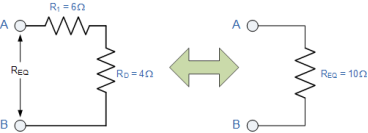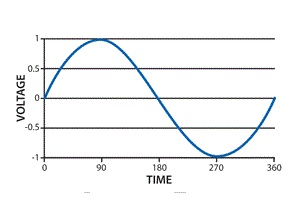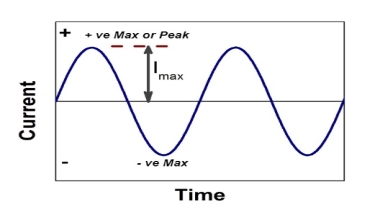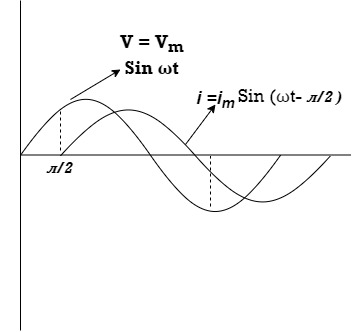|
I=V/R R=V/I |
|
Assuming the incoming current to be positive and outgoing current negative we have
I e |
|
|
|
Suppose that a current i flows through the external resistance (8 Ω) and it divides Using KCL , i1 + i2 = i |
Using KVL, For Loop ABYXA : 10 + (−i1)1 + (i − i1) 1 − 8 = 0 For Loop ABQPA : 10 + (−i1)1 + (−i)8 = 0 Solving, we get, i = 18/17 A ≈ 1.06A i1 = 10 − 8i = (10 − 8.54)A = 1.52 A. = − 0.46 A |
|
|
|
|
Ra = R9 x (R8 + R10)/ R9 + R8 + R10 = 6 x (10+2)/ 6 + 10 +2 = 4 Ω |
|
Rb = R6 x(Ra + R7)/ R5 + Ra + R7 = 6 x (4 +8) / 6 +4 +8 = 4Ω |
|
Rc = R4 x (RB + R5) / R4 + RB + R5 = 8 x (4 + 4) / 8 + 4 + 4 = 4 Ω |
|
Rd = R2 x (Rc + R3)/ R2 + Rc + R3 = 8 x (4 + 4) / 8 + 4 + 4 = 4 Ω |
|
|
N/60 = n P/2 = p |
The RMS value of AC current is equal to the steady state DC current that required to produce the same amount of heat produced by ac current provided that resistance and time for which these currents flows are identical
I rms = |
|
|
|
For the derivation we are considering only hall cycle. Thus i = Im Sin
Solving We get
Similarly, Vavg= |
It is opposition to the flow of an AC current offered by the inductor. XL = ω L But ω = 2 ᴫ F
It is measured in ohm
2. Capacitive Reactance (Xc) It is opposition to the flow of ac current offered by the capacitor Xc = Measured in ohm
| |||
Impedance (Z) The ac circuit is to always pure R Pure L and pure C it well attains the combination of these elements. “The combination of R1 XL and XC is defined and called as impedance represented as Z = R +i X Ø = 0
R = Resistance, i = denoted complex variable, X =Reactance XL or Xc | |||
Polar Form Z = Where
| |||
|
It is the cosine of the angle between voltage and current
If Ɵis –ve or lagging (I lags V) then lagging P.F. If Ɵ is +ve or leading (I leads V) then leading P.F. |
|
Consider pure Inductor (L) is connected across alternating voltage. Source V = Vm Sin ωt When an alternating current flow through inductance it setups alternating magnetic flux around the inductor. This changing the flux links the coil and self-induced emf is produced According to faradays Law of E M I | ||||
e = | ||||
at all instant applied voltage V is equal and opposite to self-induced emf [ Lenz's law] V = -e
But V = Vm Sin ωt
Taking integrating on both sides
but sin (–
And Im=
= -ve = lagging = I lag v by 900
| ||||
|
|
Power P = Ѵ. I = Vm sin wt Im sin (wt = Vm Im Sin wt Sin (wt –
And Sin (wt - | |
Sin (wt –
The average value of sin curve over a complete cycle is always zero
| |








